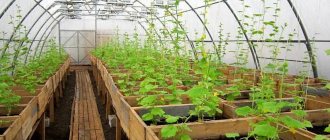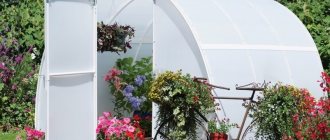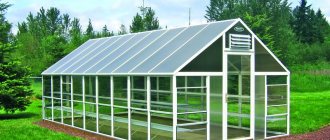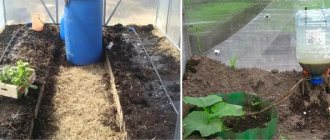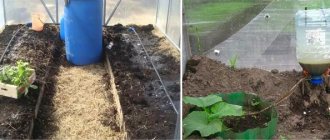A winter greenhouse is a useful structure for a plot of land that allows you to grow garden crops all year round. It is used both for personal needs and for growing fruit plants for sale.
The most versatile material for constructing greenhouses is polycarbonate. It is this that allows the use of the latest construction technologies, design developments and technical equipment for greenhouses.
Polycarbonate retains heat well and allows enough sunlight to pass through. Source plodogorod.com
Design differences between summer and winter greenhouses
The purpose of greenhouses is the same for any season - they are designed to protect plants and transfer them enough heat for growth and development. However, in terms of design, winter greenhouses differ significantly from summer buildings:
- Materials used for cladding the frame are resistant to loads, temperature changes and weather conditions. As a rule, this is glass or polycarbonate. In summer greenhouses there is enough durable film.
- Summer greenhouses warm up well during the day and the air does not have time to cool down overnight. In winter greenhouses, a heating system is required to maintain a comfortable temperature for growing.
- Winter buildings require insulation to avoid drafts and loss of thermal energy from the heating system.
- Summer greenhouses are often made in the form of arches; winter greenhouses require a gable roof so that snow does not accumulate on it.
Thus, summer greenhouses work exclusively due to natural factors - long daylight hours, solar heat, and a natural ventilation system. And in order to grow plants in winter, the necessary climatic conditions are artificially recreated in the greenhouse.
For light-loving plants it is necessary to create additional lighting Source tss.org.ru
Underfloor heating system
Installation of heated floors
An ideal option for heating the soil in a greenhouse is also a heated floor system. After all, for successful plant growth, it is the roots that need to be warmed up.
Since heating a greenhouse with electric heating elements will cost a lot of money, it is better to install a stove or boiler in it. The heating system can be combined by installing radiators around the perimeter.
- It is better to use polyethylene pipes to heat the greenhouse. They are buried to a depth of about 40-50 cm in the drainage - a layer of crushed stone and sand
- It is not advisable to use metal-plastic for laying in the ground. After all, its fittings (connecting elements) require regular tightening. If you still decide to use such hard plastic, use compensation loops when laying the pipeline
- The first to be laid is a polyethylene film, which serves as waterproofing.
- Next, a layer of thermal insulation made of polystyrene foam or expanded polystyrene is laid
- The thermal conductivity of the soil can also be reduced by using compacted sand, which is poured over the heat-insulating layer to a height of 10-15 cm
- The distance between the pipelines should be 0.36 m. To ensure uniform heating, 2 collectors are placed along the edges of the greenhouse. Pipes are connected to them alternately
- To protect the pipeline from damage when digging the soil with a shovel or pitchfork, slate or metal mesh is laid on top of it
- The next 35-40 cm layer is fertile soil
Polycarbonate in the construction of winter greenhouses
The use of polycarbonate in the construction of winter greenhouses is due to its strength and light transmission qualities. The advantages of this material are the following:
- resistance to mechanical damage;
- good aesthetic characteristics;
- light weight of the structure - suitable for any frame;
- conducts sunlight well;
- ease of processing and installation of sheets;
- the material can withstand heavy loads - important when there is a lot of snow in winter;
- tolerates strong heating and cooling, does not deteriorate under the influence of UV rays.
All these factors make polycarbonate an ideal material for the construction of winter greenhouses. It perfectly protects plants from snow and frost and allows you to maintain the correct microclimate in the building.
In a greenhouse, heat-loving plants are not afraid of early frosts Source neldekstop.ru
Laying new soil
The fertile soil layer must meet the following requirements. The soil must have the required structure and moisture capacity. This means that there should be no dust or large stones in it. The structure of the soil should be such that moisture is well retained in the ground, no matter what the temperature in the greenhouse. The soil should contain peat, river sand and compost. This is the ideal composition of fertile land that can produce high yields. Good soil allows you to do without frequent loosening.
The fertile layer must have high nutritional value. If the nutritional value is weak, the plants will not be able to gain strength. There should be no mineral salts in the soil, since tender young seedlings are not able to assimilate such “heavy food”. The soil must have a neutral background, which means that alkali and acidic salts must be present in equal quantities. Also, the fertile layer of soil must be thoroughly disinfected. To do this you need to use humic acids. The drug "Ftorine-S" will help solve the issue of disinfection.
After the new soil has been laid, it is covered with straw on top. This layer should be at least 5 cm. After a while, when snow falls, it must be placed on straw. This way you can create protection for the ground from freezing. In the spring, when the snow begins to melt, the soil will be fed with melt water. This will help the soil acquire the necessary moisture.
Greenhouse design options
The construction market offers a huge selection of shapes and sizes of greenhouses. Therefore, customers always have the opportunity to make it to suit their own needs. When choosing a design, it is worth considering the type and number of plants that you plan to grow in the greenhouse.
A heated winter greenhouse can be quite long or wide. For private land plots, there are standard dimensional grids for turnkey structures.
The base of the greenhouse is usually rectangular or square. The roof is made in various forms:
- arcuate;
- single slope;
- gable;
- multi-level.
The main condition for the roof of a winter greenhouse is the presence of a slope so that snow can slide off it under the weight of its own weight and not accumulate on the roof. It is also recommended to make vents in the roof to ventilate the structure.
Vents in greenhouses are most often located at the top point of the roof Source oteplicah.com
Greenhouses, as a rule, consist of one “room”, but experts recommend organizing a heated dressing room. This is done so that with frequent use in winter, the plants do not suffer from the penetration of cold air from the street.
See also: Catalog of companies that specialize in the installation of metal structures.
Heating
Heating options may vary. The cheapest option is to install a stove with several pipes through which heated smoke moves. As a result, hot pipes warm up the room.
The main disadvantage of this heating option is that you have to constantly add fuel to the stove and monitor the temperature inside the room.
It is much easier to use water heating. The water is heated in a gas boiler, which can be installed either in a greenhouse or in a house, connecting it to the greenhouse with a pipe.
The combined type of heating deserves special attention.
Composition of combined heating:
- infrared lighting lamps;
- polypropylene tubes buried in the ground.
The lamps heat the air from above, and the tubes from below. The main advantage is the automated control of the heating system.
Stages of construction of polycarbonate greenhouses
The construction of a winter greenhouse made of polycarbonate is a rather complex technological process. It consists of several stages that affect both the construction of the structure itself and its internal equipment. Therefore, it is better if a turnkey winter greenhouse with heating is built by experienced hands.
Foundation
A polycarbonate winter greenhouse has a heavy structure and will require laying a foundation to give it stability. It can be one of three types:
- lumber;
- stone;
- brick;
- tape
The latter option is most often used in the construction of permanent greenhouses. Laying a strip foundation is carried out in several stages:
- marking the construction site, digging a trench approximately 1 m deep;
- laying waterproofing at the bottom of the trench;
- installation of reinforcement to strengthen the foundation;
- filling the trench with gravel-sand-cement mortar;
- laying heat-insulating material on a dried strip foundation.
After preparing the foundation, anchor bolts are installed into it for subsequent fastening of the frame. Sometimes a layer of brick is laid on the foundation, in which case the fasteners must pass through the masonry and penetrate into the foundation.
Arrangement of a strip foundation for a greenhouse Source arka-green.ru
Frame installation
To build a frame under polycarbonate sheets, metal profiles, pipes and corners are most often used. This choice is due to the strength and durability of the metal base compared to wood.
Installation of the frame is carried out in several stages:
- securing the bottom lining to the foundation using anchor bolts;
- installation of vertical posts on the casing using bolts or welding;
- connection of vertical profiles with horizontal lining at the top;
- installation of a frame under a pitched roof.
The integrity and strength of the entire greenhouse structure depends on the correct installation of the base. Therefore, it is carried out exactly according to the planned plan and calculations.
The finished frame for the greenhouse remains to be sheathed with polycarbonate sheets Source homeli.ru
What type and massiveness should the foundation be made?
The more powerful, the better, of course. But let’s reveal one secret: many people use empty glass bottles to lay the foundation for such a greenhouse - as a foundation for construction. And they are right about this: it’s both cheap (almost free) and reliable. The air in the bottle serves as an excellent heat insulator, and as a result of such an undertaking, you can actually save a lot of money on cement. And building a foundation this way is not difficult:
- Step 1. Wash and dry the collected bottles well.
- Step 2. We dig a pit one meter deep.
- Step 3. We place five layers of empty bottles along the walls of the pit, sprinkling them with earth along the way.
- Step 4. On top of the bottles - two rows of bricks with strong mortar.
- Step 5. We put a timber frame on the bricks.
For such a greenhouse, the “glass” wall will also serve as a good heat-insulating wall. Cheap and cheerful, and the Siberian frosts are too tough.
Electricity
If you are planning to provide air heating by transferring heat to the carrier from an electric boiler, then this is an expensive option that is unlikely to pay for itself. However, electrical circuits are cost effective and efficient. Thus, heating a greenhouse with a pump that works with water, air or soil will create competent heating for growing crops. .
There are different schemes using a heat pump. So, ground-water is an expensive option initially, however, the operation of such a scheme and climatic conditions do not intersect with each other. The air-water scheme is cheaper, but depends on weather conditions. Unfortunately, frost of -30 completely disables the system. In this case, heat from outside enters the coolant. If the dacha is located near a reservoir, then the ideal option would be a water-to-water scheme.
Heating from the stove
A stove, and a homemade one at that, is one of the economical options for heating a greenhouse. Of course, the heat from the stove can heat the air in a heated greenhouse to the required temperature, but this option has a lot of disadvantages. The first of them is low efficiency. The second is the constant need to throw firewood with your own hands. stands on the territory of a permanent residence site. .
More modern stoves - buleryans - have a gas generator at the heart of their structure. In the apparatus, wood combustion occurs in two stages. At the end of the second, the tree generates heat for quite a long time. These are long-burning stoves that are also suitable for greenhouses.
Fuel tanks are a structure surrounded by curved pipes. The air heats up in the pipes and rises upward and then to the sides. By burning wood, such stoves evenly heat the air space throughout the greenhouse.


